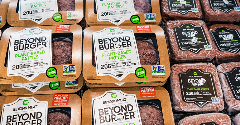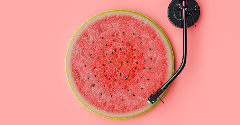sponsored content
Meeting healthy formulation challenges with beverage modelling
27 Nov 2018The beverage sector is leading the way in innovation. The European market, in particular, has evolved in recent years, with sales reaching a value of €149 billion and 16,861 new product launches in 2016.(1 & 2)With more emphasis than ever placed on time to market (TTM), manufacturers are looking to stay one step ahead of consumer demand, with the help of emerging tools, such as beverage modelling.

A diverse landscape
Today’s consumers expect so much more from their beverages, which are increasingly targeted towards different sensations, specific use moments, demographics and genders. Beverages make promises to be fresh, natural, healthy, boost energy or no additional energy sharpen mental focus, and even shrink waistlines and improve bone and joint conditions. This all covered in a delicious product taste profile. Performance smoothies, protein waters and vitamin-based energy drinks are just some examples of fortified beverage products which are now commonplace on retail shelves.While in previous years, the selection of fortified beverages was limited to shakes and smoothies, there is now an expanding range of products which falls into the functional category. For instance, it is now possible to fortify delicate bases, such as water, with whey protein and minerals, with minimal effect on overall taste and mouthfeel.
Perfecting the art
Beverages provide a great vehicle for fortification and added functionality, but this can bring formulation challenges, especially as many ingredients are known for being unpalatable. Adding calcium to beverages, for example, has historically been difficult due to its taste profile. Plus, the branched chain amino acid structure of protein molecules and vitamins means it can often be difficult to create a smooth-tasting beverage. As such, there are several considerations developers must take into account before they begin formulating a new product.Ingredient interaction
Ingredient interaction is a complex and evolving area of food chemistry, but being able to understand how the different components interact with each other is important during new product formulation. Teaming nutrients with a mix of sweeteners, colours, flavours and stabilisers, for example, can trigger a number of chemical interactions; some of which are desirable, while others should be avoided. Either way, these interactions can significantly affect the product’s overall quality, often impacting colour, taste, pH, texture, appearance and/or stability.Processing parameters
It is well known that processing parameters, such as temperature and concentration, can significantly impact the rate of reaction between molecules when formulating beverages. An increase in temperature can stimulate undesired ingredient interactions – and ultimately, unstable end products. Temperature can also affect the solubility of salts within the formulation. Generally, salts increase their solubility at increasing temperatures.Similarly, the concentration of a beverage can impact the behaviour and interaction of the electrolytes within it. As more companies are producing premixes to ship their products around the world, there is a greater risk of interaction between components at higher concentrations. As a result, formulators are challenged to create products which remain stable in application, as well as their concentrated form.
pH and titratible acidity
Beverage stability and flavour can also be affected by pH and titratible acidity. Using the right acidulants can help with this, by adding sourness, as well as controlling humectant and imparting anti-microbial properties for increased shelf life. But each acidulant has an influence on flavour profile, so they must be chosen wisely to fit the beverage. Lactic acid, for example, matches well with red fruit flavours, such as cherry, strawberry, yoghurt, dairy and cola, and can be used to mask the lingering effects of high intensity sweeteners.Osmolality
When formulating sports drinks, osmolality is essential in predicting the osmotic behaviour of the liquid – or the number of particles dissolved in a kilogram of fluid. In this category, osmolality is dependent on carbohydrate type and concentration, as well as electrolytes such as sodium, potassium, magnesium and calcium. As a result, there are three stages or solutions a sports drink can be defined as: isotonic, hypotonic and hypertonic. By varying the osmolality of sports drinks, formulators can tailor the core functional benefits.Beverage modelling innovation
Given the demands placed on manufacturers for new products, there are increasing pressures to speed up and streamline the time to market – which can often be time-consuming. It can be difficult to predict the stability and pH of a beverage, for example, without creating many different samples. And if the taste and pH measures up, but the shelf life does not, it means going back to the drawing board. Beverage modelling has been gaining attention in the industry for its ability to increase speed-to-market and R&D efficiency, as well as reduce costs, without the need for multiple samples.Increasing speed to market
Product testing can be a time intensive process and can make all the difference in whether a product is first to market. By performing scientific calculations instead of practical lab work, beverage modelling can reduce R&D time by up to 80 percent, guaranteeing fast and accurate results.(3) Unstable concepts can therefore be eliminated at an early stage. This removes the need for lengthy shelf life testing, which can sometimes take up to weeks or months, even when accelerated.Increasing R&D efficiency
Performing scientific calculations to test a beverage formulation requires much less time than practical lab work. A beverage modelling program can be used to calculate pH, osmolality and ingredient interaction within minutes. Not only this, the effect of variable factors, such as concentration or temperature, on the same recipe, can be determined much more quickly than practical testing.Reducing costs
In traditional product testing, each time a variable is modified (e.g. temperature), a new sample must be created to determine the effects of the change on the product. This can be incredibly costly. The beverage modelling process eliminates the need for multiple samples, by predicting the effect of a variable change on the product within minutes, which can reduce ingredient, equipment and labour costs.A model future
As more consumers demand beverages with multiple benefits, manufacturers are increasingly developing new product brands, varieties and formats to deliver products that cater for a wide range of nutritional needs. With new opportunities in emerging markets and the number of functional ingredients multiplying, manufacturers are under pressure to create innovative products quickly and cost effectively, to stay ahead of the competition. Using beverage modelling tools, such as Corbion’s ELECSIS™ (Electrolytes Stability in Solution), can therefore help to fuel the beverage pipeline – and increase opportunities in the category.1 Innova Market Insights, ‘Global soft drinks report 2016’, (October 2016).
2 Ibid
3 Corbion (2015)
Related news

Retail landscape lacks nutritious and affordable food, says ATNi
30 Dec 2025
A rapid increase in modern food retail has given retailers growing influence over consumer diets, according to global non-profit ATNi’s latest assessment.
Read more
Debate over ban on ‘meaty’ names for plant-based products reaches stalemate
26 Dec 2025
The debate over a ban on plant-based products using “meaty” terms has reached a stalemate, leaving manufacturers in limbo and still facing overhauls to their marketing and packaging.
Read more
Multi-sensory food and drink products to gain traction in 2026
16 Dec 2025
Trend forecasters predict that sensory elements will play a larger role, helping food and beverage brands differentiate themselves in a competitive market in 2026.
Read more
Big appetite for M&A between European and US food and drink companies
3 Dec 2025
Persistent tariffs on EU food and beverage exports have helped drive record levels of M&A activity between European and US companies this year, according to analysis by ING.
Read more
Non-UPF Program extends certification scheme to entire food industry
30 Nov 2025
The Non-UPF Program has extended its certification scheme to the wider food sector, championing a move towards healthier consumption habits.
Read more
Lancet study links UPFs to chronic disease risk
26 Nov 2025
UPFs are consistently associated with an increased risk of diet-related chronic diseases, according to a comprehensive review of global evidence in The Lancet .
Read more
Concerns swirl around cinnamon’s compliance with EU law
25 Nov 2025
Cinnamon may be a top functional ingredient, but it needs stronger protocols to ensure it meets EU food safety laws and quality standards, say researchers.
Read more
Oat Barista: Innovation for game-changing beverages
20 Nov 2025
Oat Barista is a clean label, sustainable, and innovative drink base specifically designed to create the perfect foam in one single ingredient.
Read more
How younger consumers are redefining ingredient choices and rejecting brand loyalty
18 Nov 2025
Gen Z and millennial consumers’ preferences for transparency, functionality, and purpose are “redefining the very nature of consumption itself”, says SPINS.
Read more
Hybrid formats and flexible positioning to disrupt category norms in 2026
17 Nov 2025
Trend forecasters expect food and drink to move more fluidly across occasions, functions, and formats as consumers seek versatility, novelty, and convenience.
Read more
